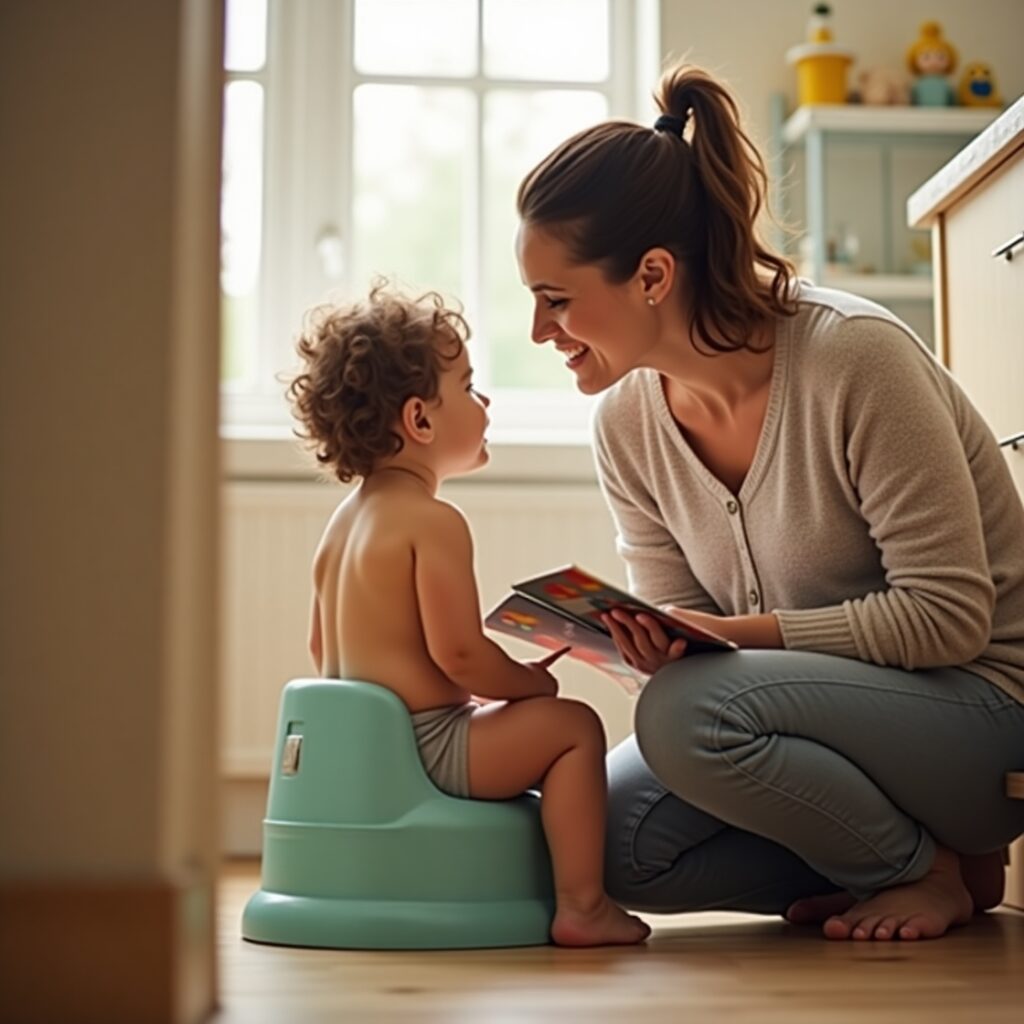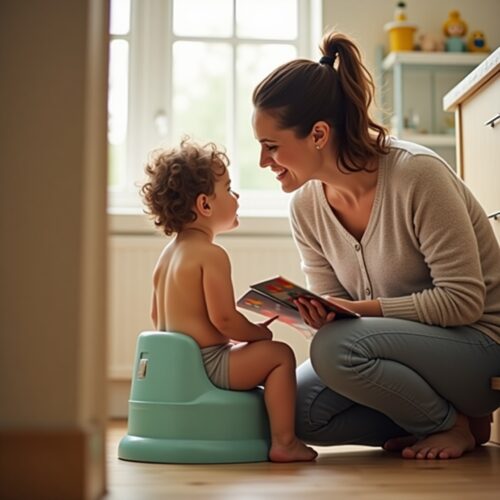Potty Training Made Easy: Your Ultimate Guide to Success (When, How & What You Need)
Ready to ditch diapers? Our ultimate potty training guide covers readiness signs, best methods, tips for boys & girls, supplies, & tackling common challenges. Start today!

Potty training – the mere mention can evoke a mix of excitement and trepidation in parents. It’s a major developmental milestone, signaling a step towards independence for your toddler. But where do you start? When is the right time? And how do you actually do it without losing your sanity?
This comprehensive guide will walk you through everything you need to know about potty training, from recognizing readiness signs to choosing the right method and navigating those inevitable bumps in the road.
How To Name Your Baby according to Nakshatra
Is Your Child Ready? Key Potty Training Readiness Signs
Timing is crucial for potty training success. Starting too early can lead to frustration for both you and your child. While age can be a factor (most children show interest between 18 months and 3 years), readiness signs are far more important than a specific age. Look for these indicators:
- Physical Readiness:
- Can walk and sit down independently.
- Stays dry for at least 2 hours at a time or wakes up dry from naps.
- Has regular, predictable bowel movements.
- Can pull their pants up and down (with a little help is okay).
- Cognitive & Verbal Readiness:
- Can understand and follow simple instructions (e.g., “Go get the ball”).
- Shows interest in the toilet or others using it.
- Can tell you (with words, gestures, or signs) when they need to go, are going, or have just gone in their diaper.
- Understands words associated with pottying (e.g., “pee,” “poop,” “potty,” “wet,” “dry”).
- Emotional Readiness:
- Expresses a desire to be independent or a “big kid.”
- Dislikes the feeling of a wet or dirty diaper.
- Is generally cooperative and not in a phase of major resistance (e.g., extreme tantrums over everything).
- Shows pride in accomplishments.
When to Start Potty Training: Finding the Right Window
Once you see a combination of these readiness signs, it’s a good indicator your child might be ready. Avoid starting during times of major upheaval, such as:
- The arrival of a new sibling
- Moving to a new house
- Starting a new daycare or preschool
- Significant illness
A calm, stable environment will make the process smoother.
Popular Potty Training Methods: Finding What Works for Your Family
There’s no single “best” potty training method; what works for one child might not work for another. Here are a few common approaches:
- The Child-Led Approach (Gradual Method):
- Focus: Follows the child’s cues and interest levels.
- Process: Introduce a potty chair, read books about potty training, let them observe you. Encourage them to sit on the potty (clothed or unclothed) when they show interest. Praise attempts and successes. It’s a low-pressure, gradual transition.
- The “Bare Bottom” or “3-Day Potty Training” Method (Intensive Method):
- Focus: Committing a few dedicated days (often a long weekend) to intensive potty training.
- Process: Ditch diapers (except for naps/night) and let your child go bare-bottomed or in underwear. Watch them like a hawk for cues, take them to the potty frequently (every 15-30 minutes initially), and offer lots of fluids. Expect accidents, but celebrate every success enthusiastically.
- Scheduled Potty Breaks:
- Focus: Establishing a routine of taking the child to the potty at regular intervals (e.g., upon waking, before/after meals, before leaving the house, before naps/bedtime).
- Process: This can be combined with other methods. The goal is to help them learn their body’s signals and increase opportunities for success.
Essential Potty Training Supplies: Gearing Up for Success
You don’t need a lot, but a few key items can make the process easier:
- Potty Chair or Seat Reducer:
- Standalone Potty Chair: Easy for little ones to access independently. Look for a stable one that’s easy to clean.
- Toilet Seat Reducer: Fits onto your regular toilet. Ensure it’s secure.
- Step Stool: Essential if using a seat reducer, allowing your child to get on the toilet and rest their feet comfortably (which helps with bowel movements).
- Training Pants or Pull-Ups: Can be a good transition from diapers, allowing kids to feel wetness but containing most messes. Some parents prefer going straight to underwear.
- Big Kid Underwear: A great motivator! Let your child pick out their own fun designs.
- Books & Videos about Potty Training: Can help normalize the process and make it fun.
- Easy-to-Remove Clothing: Think elastic waistbands, loose pants/skirts. Avoid complicated buttons or zippers.
- Cleaning Supplies: Accidents will happen! Have paper towels, disinfectant wipes, and a good attitude ready.
- (Optional) Rewards: Stickers, small treats, or a special celebratory dance can motivate some children.
Top Potty Training Tips for a Smoother Journey
- Stay Positive & Patient: This is a learning process. There will be successes and setbacks. Your calm, encouraging attitude is key.
- Praise, Don’t Punish: Celebrate every attempt and success enthusiastically. Avoid scolding or shaming for accidents; it can create anxiety and resistance.
- Make it Fun: Sing songs about the potty, read books, let them “decorate” their potty chair with stickers (on the outside!).
- Teach Proper Hygiene: Show them how to wipe properly (front to back for girls) and wash their hands thoroughly after every potty visit.
- Be Consistent: Once you start, try to be as consistent as possible with your chosen approach and expectations.
- Communicate with Caregivers: Ensure everyone involved (daycare providers, grandparents) is on the same page with your potty training plan.
- Dress for Success: Opt for clothing that’s easy for your child to pull up and down themselves.
- Listen to Your Child: If they seem truly resistant or distressed, it’s okay to take a break and try again in a few weeks.
Potty Training Boys vs. Girls: Are There Differences?
While the basic principles are the same, there are a few minor considerations:
- Potty Training Boys: Initially, it’s often easier to teach boys to pee sitting down. Once they’ve mastered that, you can introduce standing up (perhaps with some “target practice” like a Cheerio in the toilet bowl).
- Potty Training Girls: Emphasize wiping from front to back to prevent urinary tract infections (UTIs).
Tackling Common Potty Training Problems
- Accidents: They’re normal! Clean up calmly and remind them where pee and poop go.
- Resistance/Refusal: Assess if they’re truly ready. Are there stressors? Is there too much pressure? Sometimes a short break is needed.
- Fear of the Potty/Toilet: Try to understand the fear. Is it the flushing sound? The height? A standalone potty chair might feel less intimidating.
- Withholding Stool (Poop): This can be due to fear of it hurting, a previous painful experience, or control issues. Ensure they’re not constipated (plenty of fluids and fiber). Make potty time relaxed.
- Potty Training Regression: Can happen due to stress, change, or illness. Go back to basics, offer more reminders, and stay positive.
Nighttime Potty Training: A Separate Journey
Nighttime dryness is often a separate developmental milestone that can take longer to achieve than daytime dryness. It’s largely dependent on a hormone that concentrates urine during sleep.
- Don’t push it if they’re not ready. Many kids wear nighttime diapers or pull-ups for months or even years after daytime training.
- Limit fluids an hour or two before bed.
- Ensure they use the potty right before sleep.
- Consider a waterproof mattress protector.
When to Pause or Seek Professional Advice
It’s okay to hit the pause button if potty training becomes a major battle or source of stress. You can always try again in a few weeks. Consult your pediatrician if:
- You have significant concerns about your child’s readiness or progress.
- Your child experiences pain during urination or bowel movements.
- Constipation becomes a persistent issue.
- You suspect a medical reason for ongoing difficulties.
Potty training is a marathon, not a sprint. Celebrate the small victories, stay patient through the challenges, and trust that your child will get there when they’re ready. You’ve got this!
